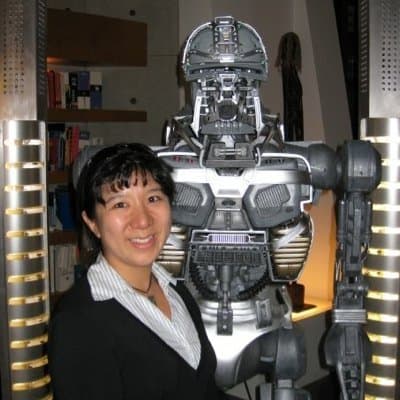Book to TV Adaptations: The Good, The Bad, and the WTH were They Thinking?
 Diana Keng
at
.
Updated at
.
Diana Keng
at
.
Updated at
.
Adapting books for television (or movies) has always come loaded with pros and cons.
On the one hand, you have a built-in fan base, ready-made characters and settings, and a tried-and-true plot.
On the other, you have purist fanatics ready to tear you a new one if your actualization of their 'verse doesn't meet their expectations on EVERY level.
I admit I may have dabbled in the fanatical side of things at times myself.
However, I (usually) understand the need to make changes to the original narrative. It may need updating, depending on when the book was written, or it may require simplifying if the source material is too convoluted for a television audience to follow.
Characters are trickier because readers get very attached to their characters.
But, again, hard decisions need to be made to shape a successful and engaging TV series, and I certainly don't envy the showrunners and/or writers that task.
Of course, I'm going to gripe with the best of them if the changes are stupid.
Far from an exhaustive list, outlined below are a few of the most popular books that became hit shows and some of the most "interesting" changes made in the adaptation process.
(I'm not including comic adaptations because I'm not looking to write my own epic here.)
True Blood
Based on Charlaine Harris' 13-volume Southern Vampire Mysteries series, True Blood ran for seven blood-soaked seasons on HBO.
Like many TV series based on multiple books, it was relatively faithful to the text in the first season before striking out for more original waters.
The Good: Lafayette Reynolds
Originally the hapless victim of a murderous Bon-Temps sex club in the book, the late Nelsan Ellis was so amazing in the role of the flamboyantly-gay Merlotte's cook, Lafayette Reynolds that he was spared the character's original demise and went on to some genuinely over-the-top adventures.
The Bad: Sam's Family
The literary Sam Merlotte had a very close relationship with his biological mother from whom he'd inherited his shapeshifter powers. He rescues her from his stepfather when his stepfather discovers her secret.
In True Blood's second season, they completely disregard that backstory in favor of Sam being abandoned by his adopted family when his powers manifest. When he tracks down his biological family, his human father is using his shapeshifter brother in dog-fights. It all comes to light on True Blood Season 3 Episode 6. Nasty.
The WTH: Fairies Suck on TV
In the books, the faeries alternate between being a source of comfort and suspicion for Sookie.
Her godmother, Claudine, is beautiful, powerful, and protective. Meeting her great-grandfather, Niall, is a magical and informative encounter. Her great-uncle, Claude, is impulsive but comes to be Sookie's closest family.
Translated to television, everything about the fairies is ridiculous and troubling.
Despite the iconic Rutger Hauer appearing as Niall on True Blood Season 6 Episode 1, the Fairy War drags on and on and on. There's a marriage contract out on Sookie to a vampire-fairy hybrid.
And as for Jessica killing/eating Sheriff Andy's fairy daughters on True Blood Season 6 Episode 5? Possibly the most terrifying single parent cautionary tale EVER.
Related: Get HBO via Prime Video Channels for Addictive Dramas, Hilarious Comedies, & Hit Movies!
Game of Thrones
Based on George R.R. Martin's epic saga The Song of Ice and Fire, the television adaptation has out-paced the books and progressed the story beyond the five volumes published so far.
There are two more books planned, but the next publication date is still unconfirmed, much to readers' dismay.
Martin has assured fans that the books and the series will dovetail in their conclusions.
The Good: Aging Up Daenerys
As sensational as HBO's programming prides itself as being, even they weren't going to be able to carry off marrying a 13-year-old girl to a barbarian warlord on Game of Thrones Season 1 Episode 1 to be deflowered and impregnated.
Mind you; the books also described Khal Drogo as being a far more compassionate and civilized husband than portrayed in the HBO series.
The Bad: NO Stoneheart
In the third book of the series, A Storm of Swords, the body of Catelyn Stark is found floating in the river three days after the massacre of the Red Wedding and brought back to life by Beric Dondarrion using the power of the Lord of Light.
The resurrected Catelyn assumes the name Lady Stoneheart and proceeds to lead the Brotherhood Without Banners, hunting down anyone related to the Freys, Lannisters, or Boltons, and executing them without mercy.
For a season or two, I held out hope that the television series would bring Lady Stoneheart into play. Unfortunately, Martin confirmed in an interview that Lady Stoneheart would not be appearing on the show and went on record saying that her absence was regrettable.
The WTH: Talisa
Full disclosure: I spent a LOT of time yelling at my TV during Game of Thrones Season 3 when Robb Stark fell in love with Talia, a character wholly invented for the TV show. If she had survived the Red Wedding on Game of Thrones Season 3 Episode 9, I would have stopped watching altogether.
Robb Stark of the novels was the heir, both biological and spiritual, to Eddard. They were both too noble to survive the Game of Thrones they were forced to play.
In both book and show, the Freys supposedly planned the Red Wedding massacre because Robb had married someone other than the Frey girl to whom he had sworn his hand.
In the book, Robb breaks his oath because he had taken advantage of Jeyne Westerling while recovering in her family home, where he had received news that his brothers had gotten murdered. Jeyne, who was acting as his nurse, "comforted" him in his grief.
Out of a sense of duty, Robb married her. She outlives him, as she was left behind when he went to make amends to the Freys, thus missing out on the Red Wedding.
In creating the improbable and singular Talisa and having Robb consciously break his oath in favor of passion (and whatever), the show not only betrayed the readership but made Robb unworthy of his role as Eddard's son. Death by betrayal was the obvious consequence.
Related: Game of Throne Season 8 -- HBO Releases New Footage!
The Handmaid's Tale
The Good: Representation
The original novel by Margaret Atwood, published in 1985, built a Republic of Gilead which is exclusively white. All people of color have been relocated or exterminated. In creating the television adaptation, there was a conscious decision to ignore the question of race altogether.
On the surface, it is the best decision for both social representation and audience identity. It's kind of a no-brainer.
However, the subtext is that the television Gilead is more tolerant than that of the novel. Making that society seem "better" in any respect is a dangerously slippery slope.
The Bad: The Updated Serena Joy
The novel was published with the backdrop of the 1980s, a decade full of larger-than-life television personalities, and those reading the book at the time would have immediately recognized Serena Joy as a thinly-veiled homage to Tammy Faye Bakker.
Described in the novel as a former singer and TV evangelist who could cry on cue, she is a bitter woman, trapped in a domestic setting and desperate to mother a child.
Her motivations are pretty straight-forward, and although she is obviously unhappy in her life, the Serena Joy in the book is a recognizable celebrity to Offred from the before-times.
Understandably, although unfortunate, the Bakker reference is dated, so the show develops a backstory for her as an active fundamentalist who helped shape Gilead's ideology, an ideology that eventually shut her out of any political decision-making as her place as a woman is in the home.
As with the diversifying of the cast, this turns a character who had very simple, unlikable traits on paper into a more nuanced, sympathetic character on screen. It's a very different direction which is clear from her initial scene on The Handmaid's Tale Season 1 Episode 1.
The WTH: Sexifying the Marthas
"Martha" is the title given to a caste of women who are post-menopausal, and therefore infertile, who are kept as housekeepers and nannies to families of higher status because they are compliant and have domestic skills.
The Marthas on the TV series are obviously NOT post-menopausal. It has gotten implied that they are usually women of color who are not suitable to be Handmaids.
Also, they apparently have a best-before date, as well, as Offred gets told the Marthas are sent away once they are "past their prime."
Related: The Handmaid's Tale Season 3 -- Super Bowl Ad Teases Another Uprising
American Gods
One of Neil Gaiman's epic sagas, the adaptation of American Gods Season 1 only managed to transfer a third of the novel to screen.
A phenomenally lush and rich weaving of narratives, it drives a powerful main plot forward with plenty of action while giving detailed backstories to the gods and people alike.
It's one of the best adaptations to date.
The Good: Laura Moon
Vitally important, yet with questionable motivations in the novel, the TV adaptation manages to flesh out the character of Shadow's reanimated late wife, Laura Moon.
Her backstory on American Gods Season 1 Episode 4 gives us incredible insight into the type of woman she is and what Shadow means to her.
The Better: New Gods
There was no choice in changing the novel's new gods for the television series. It was essential to update the novel, and they nailed it.
The New Gods (Technology, Media, Globalization) of the 2001 publication have evolved by 2017, and the updated versions are slicker, slimmer, and far more sinister in their powers than could ever have been imagined at the dawn of the 21st Century.
The casting was brilliant across the board with Gillian Anderson's Goddess of Media appearing as Lucille Ball (on American Gods Season 1 Episode 2) and Marilyn Monroe (on American Gods Season 1 Episode 5) to fantastic effect.
Wouldn't you like an upgrade? A brand new, lemon-scented you?
Media [as Marilyn Monroe]
Crispin Glover NEVER seems to age which is perfect for Mr. World, the God of Globalization.
And Bruce Langley is precisely today's image of the Silicon Valley Technical Boy.
Wednesday is history, forgotten and old. He should just let it happen. We are the future. We don't give a fuck about him or anyone like him. They are consigned to the dumpster.
Technical Boy
The Worst: The Agony of the Slooooooow Roll-Out
With two-thirds of the story left to tell (OMG the HOUSE ON THE ROCK!), and a potential sequel in the works, American Gods Season 2 is probably the most exciting thing on my 2019 watchlist.
But it's been nearly TWO years. Seriously.
So Many Others
It's a dangerous endeavor to undertake, recreating someone's imagined story for the screen. But in a world with so much good TV, there is always a potential for brilliance.
So come at me with your favorite and most disappointing adaptation choices.
Who improved on the original work?
Who should hang their heads in shame?
Who destroyed a part of your soul with their casting/script/plot choices?
Diana Keng was a staff writer for TV Fanatic. She is a lifelong fan of smart sci-fi and fantasy media, an upstanding citizen of the United Federation of Planets, and a supporter of AFC Richmond 'til she dies. Her guilty pleasures include female-led procedurals, old-school sitcoms, and Bluey. She teaches, knits, and dreams big. Follow her on X.
























